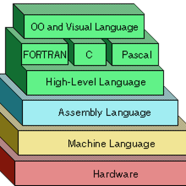High-level programming languages
High-level programming languages are written and composed in a method that is near our human language, empowering to programmers and software engineer to merely center around the issue being tackled.
No specific information of the hardware is required an as high level of programming language make programs that are versatile and not fixing to a particular PC or microchip.

These programmer friendly and responsive languages are named ‘high level’ as they are far expelled from the machine code instructions comprehended by the PC.
The first and primary high-level languages were presented in the year 1950’s. These days, high-level languages are in extensive utilization. These comprise Visual Basic, Ruby, Python, PHP, Perl, Pascal, Java, FORTRAN, Cobol, C++, C, BASIC.
Examples are containing: Visual Basic, Python, Pascal, Java, C++.
Benefits:
• Easier to change as it utilizes English like statements.
• Faster/easier to compose code as it utilizes English like statements.
• Easier to troubleshoot amid development because of English like statements.
• Portable code, not intended to keep running on only one sort of machine.
Types of high-level language:
Following are the kinds of high-level languages.
1. Procedural languages:
A grouping of instructions and directions is run. There is a beginning stage as well as a logical order to the directions to be implemented and executed, until the point that the endpoint is coming.
Procedural programming language utilizes program control develops (If, functions, subroutines, loops, then).
Examples of the procedural languages:
• PASCAL
• COBOL
• FORTRAN
• BASIC
2. Event-driven languages:
This is a program that sits tight for the events, for example, the clicking of a mouse or else the press of any key on the keyboard.
At the point when an occasion happens, it is prepared to utilize a characterized succession of instructions named an event handler.
Helpful for the control programs where occasions or events, for example, readings from the sensors are utilized to control gadgets.
Examples of the driven languages:
• Visual Basic
• C++
• Javascript
3. Visual languages:
Enable the programmer or software engineer to control the objects visually or outwardly on a form, setting the properties and layout. The fundamental program code is consequently and automatically produced.
Utilized for making Windows applications (GUI).
Examples of the visual languages:
• Visual Basic
• Visual C++
• Delphi
4. Object-oriented language (OOP):
A type of high programming language where the objects are clear and defined.
Objects consist of methods and properties.
Properties might be set at first or altered at run-time.
Methods and strategies are the things that object might do.
Examples of object-oriented language:
• Visual Basic
• C#
• JAVA
• PYTHON
5. Mark up languages:
Guidelines and instructions for the special coding are utilized to show the layout and style of text as well as different components and elements.
Broadly utilized for making website pages on the Web.
Examples of markup languages:
• HTML
• ASP
• XHTML
• XML







Recent Comments